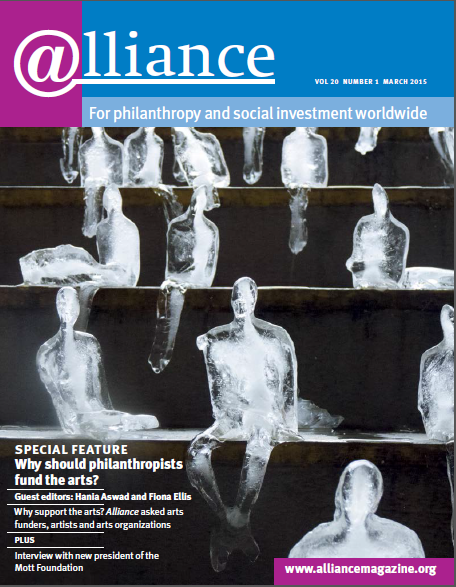Many of us have a deeply held belief that art matters to society, that artists’ experiments and creative explorations lead us to ourselves and teach us about our societies. Across generations and countries, there are a multitude of examples of art, in all its forms, connecting hearts and minds, challenging boundaries of understanding, propelling movements forward, awakening collective consciousness.
While socially engaged art has long existed, it is only recently that the philanthropic sector has ‘caught on’. Art and social justice funding is now a trend – after being marginalized within both the art world and social justice arenas. Foundations want to break out of programme ‘silos’ and explore creative interventions in order to be more efficient and relevant. Similarly, interest and attention have been focused on measurement and evaluation as a way for foundations to show impact and the potential ‘scale up’ of solutions.
Leading an ‘arts and social justice’ foundation, the Lambent Foundation, I rebel against the idea of designing metrics to validate the impact of arts and social justice work. Standardized measurements fall drastically short in allocating value to artistic practice, failing to notice and account for the transformative power of art. Along with other artists, organizers, and funders, I am struggling with this imposed mandate of measurement. How can meaningful acts of creativity and beauty and alternative ways of seeing and knowing be measured – measured against what? Can we really ‘weigh the imagination’?
With a funding history in social justice issues and progressive movement building, Lambent Foundation was founded with the intention of elevating art and culture to serve as a strategy alongside organizing and advocacy to support progressive social change. But this isn’t easy.
The problem is that artists and social justice organizers do not necessarily share the same vernacular: it’s process versus tactics. Aesthetics operate within individual value systems shaping taste and notions of quality. Social justice organizing – intended to shift dialogues, mobilize engagement and potentially have an impact on public policy – has clear, campaign-oriented goals based on a collectively held narrative with a determined timeline which is more adaptable to metrics and measurement. Targeted short-term outcomes such as audience engagement, increased access and awareness campaigns can promote general awareness of inequities and complex social challenges. However, art interventions around structural justice issues require a deeper investment of time, understanding and resources – often challenging philanthropic guidelines and grant periods. And there are very few opportunities for the two sides to come together to understand each other’s intentions and practices.
Another problem is that people often take an oversimplified and limited view of art and culture as entertainment-focused rather than valuing the making of art as labour and artists as contributors to local and national economies and as community leaders of healthy, vibrant neighbourhoods. It is important for artistic practice to be equally valued and not marginalized within an art and social change framework.
Against these challenges, formal networks (such as Americans for the Arts, Animating Democracy and Grantmakers in the Arts) and informal local/regional collectives have developed shared-learning communities to develop ‘better’ practices and move the arts and social justice field forward. Multiple and diverse artist-centred organizations and individual artist practices have been attempting to design evaluative tools that value both artistic and justice-based objectives.
As grantmakers, it is important to work directly and collaboratively with grantee partners to explore and construct evaluative measurements and assessment models that address both funder and grantee needs. We need to share our learning and discoveries, not to provide a panacea but to engage in practices that are evolving, relevant and responsive to our complex and turbulent times. We, the funders, are the ones mandating metric models; we can also make a choice to work in partnership with our boards and grantees to design adaptive models that permit flexibility and really serve the generative and creative nature of our work.
A more just and beautiful world is truly possible. As funders, let’s view ourselves as practitioners alongside artists and cultural workers and organizers and together we can create that world.
Michelle Coffey is executive director of the Lambent Foundation. Email mcoffey@lambentfoundation.org
Lead image: ‘This is my metal basket for catching fish. It already has erosions from the sea, what remains is just its structure, now it is just a memory …’ From ‘Yemeni Women with Fighting Spirits’, a photography and installation project by Amira Al-Sharif, Yemen, supported by the Arab Fund for Arts and Culture.







Comments (0)